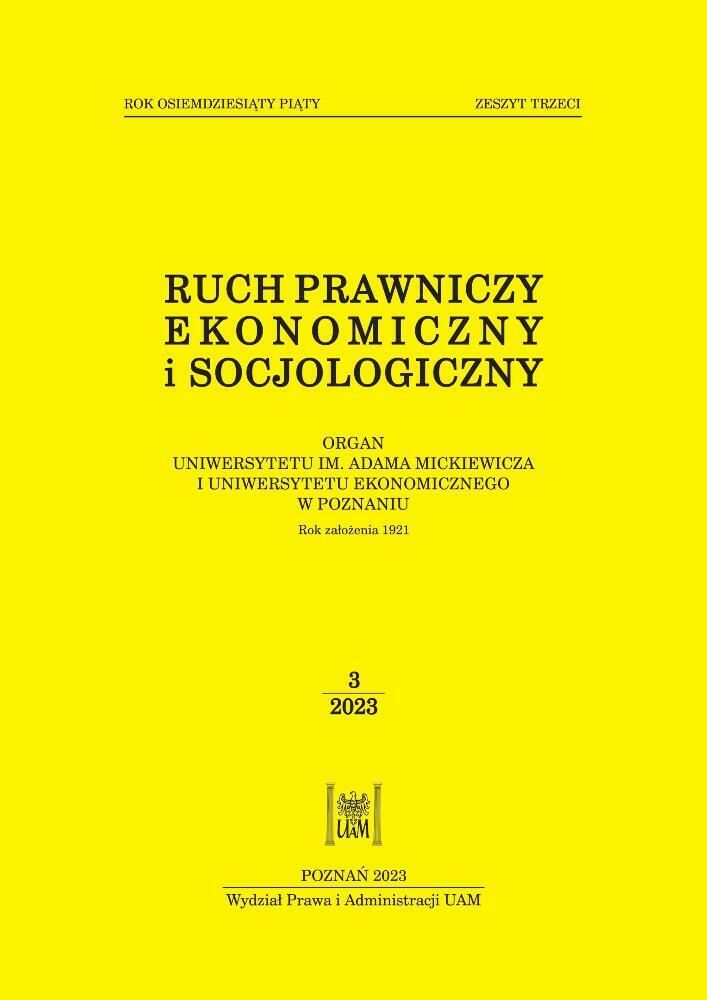Abstrakt
The depreciation of values, combined with the expansion of agriculture, industry and the economy, results in the erosion of existing protection mechanisms, as well as commodification and dominance of economic factors. The increasing degradation of the natural environment reveals an increasing number of areas requiring urgent and coordinated protection. The aim of the article is to present the innovative concept of green courts, which are creating a new architecture of modern environmental law. In the considerations, it is indicated that ‘green’ courts at a national level open the way to formulate new legal institutions, facilitate more effective the enforcement of environmental law, and solve legal disputes with alternative adjudicative processes. The article discusses environmental justice based on the example of India and New Zealand, which are among the first countries in the world to have developed an innovative judicial structure and environmental case law. The dogmatic method plays an essential role in the analysis of legal norms concerning the protection of environment, as well as in determining their content and scope. The source materials originate from various legal orders, and diverse cultural and geographical regions. Therefore, in order to discuss the indicated issues, it is necessary to use the comparative method, and thus complete the arguments of a dogmatic and legal nature. In order to present the origins and evolution of law in the scope concerning ‘green’ courts, the historical and legal method is used (temporal retrospection). The considerations emphasize the role of specialist ‘green’ courts in maintaining a balance between the economy, the development of society, and protecting the environmental wellbeing by shifting the focus of jurisprudence to the environmental domain. The article highlights the role of the application and interpretation of environmental norms from an ethical and intergenerational perspective.
Bibliografia
Amirante, D. (2012). Environmental courts in comparative perspective: preliminary reflections on the National Green Tribunal of India. Pace Environmental Law Review 29(2): 441–469. https://digitalcommons.pace.edu/cgi/viewcontent.cgi?article=1693&context=pelr DOI: https://doi.org/10.58948/0738-6206.1693
Birdsong, B.C. (2002). Adjudicating sustainability: New Zealand’s Environment Court. Ecology Law Quarterly 29(1): 1–69. https://scholars.law.unlv.edu/cgi/viewcontent.cgi?article=1307&ontext=facpub
Brara, R. (2018). Courting Resilience: The National Green Tribunal, India. Working Paper No. 2018–4, March 2018. Geneva: United Nations Research Institute for Social Development (UNRISD).
Chaturvedi, A.K. (2019). River Water Pollution – A New Threat to India: A Case Study of River Ganga. New Delhi: Vivekananda International Foundation.
Clark, S.S.; Miles, M.L. (2021). Assessing the integration of environmental justice and sustainability in practice: a review of the literature. Sustainability 13(20): 1–23. https://www.mdpi.com/2071-105013/20/11238 DOI: https://doi.org/10.3390/su132011238
Dhanda, R. (2019). The role of the National Green Tribunal in furthering the object of environment protection. International Journal of Law Management & Humanities 2(2): 1–19. https://www.ijlmh.com/wp-content/uploads/2019/05/The-Role-of-the-National-Green-Tribunal-in-furthering-the-object-of-Environment-Protection.pdf
Divan, S., Rosencranz, A. (2022). Environmental Law and Policy in India. Oxford: Oxford University Press. DOI: https://doi.org/10.1093/oso/9780192865458.001.0001
Gill, G.N. (2020). Mapping the power struggles of the National Green Tribunal of India: the rise and fall? Asian Journal of Law and Society 7(1): 85–126. DOI: https://doi.org/10.1017/als.2018.28
Harris, B.V. (1993). Sustainable management as an express purpose of environmental legislation: the New Zealand attempt. Otago Law Review 8(1): 51–76. http://www.nzlii.org/nz/journals/OtaLawRw/1993/3.html
Higgs, S. (2007). Mediating sustainability: the public interest mediator in the New Zealand Environment Court. Environmental Law Review 37(1): 61–104. https://law.lclark.edu/live/files/283-371higgs
Holifield, R. (2001). Defining environmental justice and environmental racism. Urban Geography 22(1): 78–90. https://www.nypl.org/sites/default/files/holifield_defining_ej_and_environmental_racism.pdf DOI: https://doi.org/10.2747/0272-3638.22.1.78
Jollands, N., Harmsworth, G. (2007). Participation of indigenous groups in sustainable development monitoring: rationale and examples from New Zealand. Ecological Economics 62(3/4): 716–726. https://www.sciencedirect.com/science/article/abs/pii/S0921800906004654 DOI: https://doi.org/10.1016/j.ecolecon.2006.09.010
Khera, A. (2019). Sustainable development and environment protection in India: a critique. International Journal of Applied Business and Economic Research 17(3): 17–20.
Kumar, V. (2020). Establishment of green courts in India and their role in discharging climate justice – a jurisprudential analysis. US-China Law Review 17(7): 300–316. https://www.davidpublisher.com/Public/uploads/Contribute/5ff6e9481d8fd.pdf DOI: https://doi.org/10.17265/1548-6605/2020.07.004
Lau, M., Cha, M. (2007). Introduction to environmental justice in the rural and natural resource context in South Asia. In M.S. Vani, R. Asthana, N. Belbase, L.B. Thapa, P. Moore, F. Pastakia, Environmental Justice and Rural Communities: Studies from India and Nepal (pp. ix–xii). Bangkok: International Union for Conservation of Nature and Natural Resources (IUCN).
Magallanes, C.J.I. (2020). Nature as an ancestor: two examples of legal personality for nature in New Zealand. Victoria University of Wellington Legal Research Papers, Paper No. 54/2020, 10(16): 1–19.
Meurk, C.D., Blaschke, P.M., Simcock, R.C. (2013). Ecosystem services in New Zealand cities. In J.R. Dymond (ed.), Ecosystem Services in New Zealand: Conditions and Trends (p. 254). Lincoln: Manaaki Whenua Press.
Ministry (2022). Ministry for the Environment & Stats NZ, Environment Aotearoa 2022. New Zealand’s Environmental Reporting Series. Wellington.
Pandey, A. (2017). Environmental justice delivery system in India: tracing the evolution of green justice. South Asian Law Review Journal 3: 30–54.
Pring, G., Pring, C. (2016). Environmental Courts & Tribunals: A Guide for Policy Makers. Nairobi: United Nations Environment Programme (UNEP). https://www.ecolex.org/details/literature/environmental-courts-tribunal-a-guide-for-policy-makers-mon-091260/ DOI: https://doi.org/10.4337/9781783478408.II.34
Prusty, Ch.A. (2018). POSCO India: a case study. Indian Journal of Society and Politics 5(1): 79–84. https://ijsp.in/article_description.php?post_id=POSCO%20India:%20A%20Case%20Study
Robinson, N.A. (2018). The nature of courts. In C. Voigt, Z. Makuch (eds.), Courts and the Environment (pp. 29). Cheltenham-Northampton: The IUCN Academy of Environmental Law Series, Edward Elgar Publishing.
Saheb, S.U., Seshaiah, S., Viswanath, B. (2012). Environment and their legal issues in India. International Research Journal of Environment Sciences 1(3): 44–51. https://nqr.gov.in/sites/default/files/File_Para%20Legal%20practices.pdf
Sahin, Ü.A., Harrison, R.M., Alam et al. (2022). Measurement Report: interpretation of wide-range particulate matter size distributions in Delhi. Atmospheric Chemistry and Physics 22(8): 5415–5433. https://acp.copernicus.org/articles/22/5415/2022/acp-22-5415-2022.pdf DOI: https://doi.org/10.5194/acp-22-5415-2022
Sharma, R. (2008). Green Courts in India: strengthening environmental governance? LEAD Journal (Law, Environment and Development Journal) 4(1): 52–71. http://admin.indiaenvironmentportal.org.in/files/Green%20Courts.pdf
Warnock, C. (2014). Reconceptualising the role of the New Zealand Environment Court. Journal of Environmental Law 26(3): 507–518. DOI: https://doi.org/10.1093/jel/equ030
Warnock, C. (2020). Environmental Courts and Tribunals: Powers, Integrity and Search for Legitimacy. Oxford, London, New York, New Delhi, Sydney: Hart Publishing. DOI: https://doi.org/10.5040/9781509940097
Licencja
Prawa autorskie (c) 2023 WPiA UAM

Utwór dostępny jest na licencji Creative Commons Uznanie autorstwa 4.0 Międzynarodowe.





